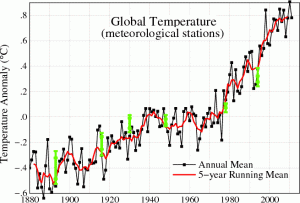One way to know you’re dealing with scientific theory is it makes testable predictions. So it is with the theory of climate change 20 years ago, and now we know, the predictions were valid:
Livescience — The accuracy of the 1990 predictions is notable because scientists, 22 years ago, relied on much more simplistic computer models than those now used to simulate the future, said one of the researchers behind the current analysis, Dáithí Stone, now a research scientist at Lawrence Berkeley National Laboratory. He worked on the analysis while at the University of Cape Town and University of Oxford. …
The 1990 report offered a best estimate of an increase of 2 degrees Fahrenheit (1.1 degrees Celsius) by 2030, which at the halfway point in 2010, translates to warming of 1 degree F (0.55 degrees C). Stone and Frame compared this expected increase to two sets of temperature records for 1990 through 2010, which showed increases of 0.63 degrees F (0.35 degrees C) and 0.7 degrees F (0.39 degrees C), respectively.
Ding ding ding! We have a valid prediction. What next? As far as the science there are more complicated predictions already made by various researchers. Those that are borne out will be vindicated. Meanwhile, the earth’s cryosphere melts and our oceans warm.


Actually, it doesn’t show that the predictions were accurate, it shows that the predictions underestimated the temperature change. For years, many so-called “skeptics” have tried to point at the uncertainty to claim that the warming isn’t real, while many real skeptics have been pointing out that the uncertainty could just as easily point in the other direction. Guess we now know who was right.
Science schmience. You know that those liberal NASA people are just trying to save their jobs and get raises. Heck it is much colder now than it was 2 months ago…
Just wanted to get that out there before the real trolls start…
Deen: how does it show that the predictions underestimated the change? Their best case scenario was a warming of 1 degree F by now, and the actual data says the warming was slightly less than that, unless I’m reading it very wrong.
So their predictions slightly over-estimated the change (although of course the error bars may make the difference non-significant). At any rate, no sign of an under-estimation, is there?
Did anyone else’s UI just flip text to bizzare weird characters?
@Stephen: Not mine.
@ Enkidum: I wonder if we would’ve seen the full 1 degree F change if they looked at sea temps rather than air/surface temps.
As the linked article says,
So they’ve corrected for ENSO and volcanos (at least Mt. Pinatubo). Rahmstorf, Foster, and Cazenave(2012) did the same thing, and found the same result. There’s a very nice discussion at Skeptical Science.
@Deen #1
“The 1990 report offered a best estimate of an increase of 2 degrees Fahrenheit (1.1 degrees Celsius) by 2030, which at the halfway point in 2010, translates to warming of 1 degree F (0.55 degrees C). Stone and Frame compared this expected increase to two sets of temperature records for 1990 through 2010, which showed increases of 0.63 degrees F (0.35 degrees C) and 0.7 degrees F (0.39 degrees C), respectively.”
If it was supposed to warm by 0.55 degrees C and it has only warmed 0.35 degrees C, I think you’ll find they overestimated. Not that it matters for the sake of 0.25 degrees; the theory holds water.